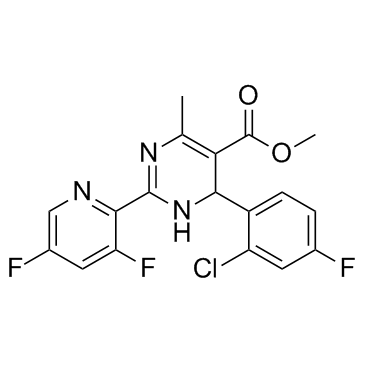BAY 41-4109 racemate is the racemic mixture of BAY 41-4109 which is a novel and potent inhibitor of human hepatitis B virus (HBV) with an IC50 of 53 nM. BAY-41-4109 is a heteroaryldihydropyrimidine (HAP) antiviral compound effective on Hepatitis B virus (HBV) capsid assembly and on preformed HBV capsids.
Physicochemical Properties
| Molecular Formula | C18H13CLF3N3O2 |
| Molecular Weight | 395.76 |
| Exact Mass | 395.06 |
| Elemental Analysis | C, 54.63; H, 3.31; Cl, 8.96; F, 14.40; N, 10.62; O, 8.09 |
| CAS # | 298708-79-9 |
| Related CAS # | Bay 41-4109;298708-81-3;Bay 41-4109 (less active enantiomer);476617-51-3 |
| PubChem CID | 9865484 |
| Appearance | Light yellow to yellow solid powder |
| Melting Point | 126 °C |
| LogP | 3.1 |
| Hydrogen Bond Donor Count | 1 |
| Hydrogen Bond Acceptor Count | 7 |
| Rotatable Bond Count | 4 |
| Heavy Atom Count | 27 |
| Complexity | 645 |
| Defined Atom Stereocenter Count | 0 |
| SMILES | O=C(C1=C(C)N=C(C2=NC=C(F)C=C2F)NC1C3=CC=C(F)C=C3Cl)OC |
| InChi Key | FVNJBPMQWSIGJK-UHFFFAOYSA-N |
| InChi Code | InChI=1S/C18H13ClF3N3O2/c1-8-14(18(26)27-2)15(11-4-3-9(20)5-12(11)19)25-17(24-8)16-13(22)6-10(21)7-23-16/h3-7,15H,1-2H3,(H,24,25) |
| Chemical Name | Methyl 4-(2-chloro-4-fluorophenyl)-2-(3,5-difluoropyridin-2-yl)-6-methyl-1,4-dihydropyrimidine-5-carboxylate |
| Synonyms | BAY-414109; BAY414109; BAY 414109; BAY-41-4109; BAY41-4109; BAY 41-4109 |
| HS Tariff Code | 2934.99.9001 |
| Storage |
Powder-20°C 3 years 4°C 2 years In solvent -80°C 6 months -20°C 1 month |
| Shipping Condition | Room temperature (This product is stable at ambient temperature for a few days during ordinary shipping and time spent in Customs) |
Biological Activity
| Targets | HBV(IC50= 53 nM ) |
| ln Vitro | In vitro, BAY 41-4109 has the capacity to misdirect and speed up capsid assembly. BAY 41-4109 stabilizes formed capsids up to a ratio of one inhibitor molecule for every two dimers [2]. In HepG2.2.15 cells, BAY 41-4109 exhibits an equivalent level of efficacy in suppressing HBV DNA release and cytoplasmic HBcAg levels, with IC50 values of 32.6 and 132 nM, respectively. The dose-dependent inhibition of HBV DNA and HBcAg suggests that the anti-HBV mechanisms are linked to and reliant on the rate of HBcAg inhibition[3]. |
| ln Vivo | With an efficacy similar to 3TC, BAY 41-4109 decreases viral DNA in the liver and plasma in a dose-dependent manner. Hepatitis B virus core antigen (HBcAg) in the livers of HBV-transgenic mice is decreased by BAY 41 -4109. Research on pharmacokinetics in mice has demonstrated quick absorption, a 30% bioavailability, and dose-proportional plasma concentrations in rats and dogs of roughly 60%[1]. By targeting the viral capsid, BAY41-4109 inhibits the production of viruses in vivo[2]. |
| Cell Assay | MTT colorimetry is used to measure cellular metabolism. In 96-well plates, HepG2.2.15 cells are plated at a density of 2 × 103 cells per well. 20 μL of MTT solution (5 g/L) is added to each well after 8 days of treatment with varying concentrations of each antiviral compound, and the wells are then incubated for 4 hours at 37°C. To dissolve the crystals, 150 μL of DMSO is then added and stirred for 10 minutes. An ELISA reader is used to record absorbance values at 490 nm. The curve regression equation is used to compute the MTT values[3]. |
| Animal Protocol | Mice: For this study, HBV-transgenic mice are employed. The compounds (BAY 41-4109) are given to mice twice a day for 28 days in a suspension solution formulated with 0.5% tylose. The placebo is the 0.5% tylose. The animals are killed six hours after the last treatment, and the livers are taken out and frozen right away for further examination. The anesthetized animals' hearts are punctured to obtain blood[1]. |
| References |
[1]. Inhibition of human hepatitis B virus (HBV) by a novel non-nucleosidic compound in a transgenic mouse model. Antiviral Res. 2002 May;54(2):69-78. [2]. BAY 41-4109 has multiple effects on Hepatitis B virus capsid assembly. J Mol Recognit. 2006 Nov-Dec;19(6):542-8. [3]. Inhibition of hepatitis B virus replication by Bay 41-4109 and its association with nucleocapsid disassembly. J Chemother. 2008 Aug;20(4):458-67. |
Solubility Data
| Solubility (In Vitro) |
DMSO : 50~79 mg/mL ( 126.34~199.61 mM ) Ethanol : ~11 mg/mL Water : ˂1 mg/mL |
| Solubility (In Vivo) |
Solubility in Formulation 1: 2.5 mg/mL (6.32 mM) in 10% DMSO + 40% PEG300 + 5% Tween80 + 45% Saline (add these co-solvents sequentially from left to right, and one by one), suspension solution; with sonication. For example, if 1 mL of working solution is to be prepared, you can add 100 μL of 25.0 mg/mL clear DMSO stock solution to 400 μL PEG300 and mix evenly; then add 50 μL Tween-80 to the above solution and mix evenly; then add 450 μL normal saline to adjust the volume to 1 mL. Preparation of saline: Dissolve 0.9 g of sodium chloride in 100 mL ddH₂ O to obtain a clear solution. Solubility in Formulation 2: 10% DMSO+40% PEG300+5% Tween-80+45% Saline: 2.5 mg/mL (6.32 mM) (Please use freshly prepared in vivo formulations for optimal results.) |
| Preparing Stock Solutions | 1 mg | 5 mg | 10 mg | |
| 1 mM | 2.5268 mL | 12.6339 mL | 25.2678 mL | |
| 5 mM | 0.5054 mL | 2.5268 mL | 5.0536 mL | |
| 10 mM | 0.2527 mL | 1.2634 mL | 2.5268 mL |
